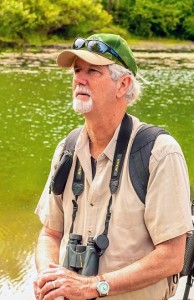 Large ancient white oaks (Quercus garryana) with their broad, rounded canopies are one of the Willamette Valley’s most profound residents. Their deep incised bark, lustrous green-colored lobed leaves and stout gnarled limbs make for a beautiful and majestic tree. Thin strands of lichen drape from their branches, their upper canopies are often filled with bunches of mistletoe, and thick vines of poison oak cover their lower trunks which adds to the image of an organism that is primal and deeply rooted in the history of the Valley. On fertile soils, the trunks of some legacy oaks may be 5 feet in diameter. Occasionally when a large oak is toppled by a winter wind storm and after the huge trunks are cut for removal, I try to count the rings but soon lose patience because they are too numerous and tightly grained. They were old trees when Lewis and Clark paddled down the Columbia River and David Douglas rode under their huge limbs traveling south on his way to the Umpqua Valley.
Large ancient white oaks (Quercus garryana) with their broad, rounded canopies are one of the Willamette Valley’s most profound residents. Their deep incised bark, lustrous green-colored lobed leaves and stout gnarled limbs make for a beautiful and majestic tree. Thin strands of lichen drape from their branches, their upper canopies are often filled with bunches of mistletoe, and thick vines of poison oak cover their lower trunks which adds to the image of an organism that is primal and deeply rooted in the history of the Valley. On fertile soils, the trunks of some legacy oaks may be 5 feet in diameter. Occasionally when a large oak is toppled by a winter wind storm and after the huge trunks are cut for removal, I try to count the rings but soon lose patience because they are too numerous and tightly grained. They were old trees when Lewis and Clark paddled down the Columbia River and David Douglas rode under their huge limbs traveling south on his way to the Umpqua Valley.
Savannas characterized by scattered large oaks in upland prairies covered a good part of the Willamette Valley prior to the arrival of Euro-American fur trappers and settlers. Native Americans burned the prairies in the valley to create vast fields of camas and lush grass forage for deer and elk in the springtime. White oaks are fire-resistant so the burning kept conifers from encroaching on oak savannas and open oak woodlands, and created unique understories filled with a wonderful variety of native grasses and forbs.
Most of these large white oaks are gone. Farmers cut them down so they could work their fields or harvested the trees for lumber. Conifers regenerated in many of the oak dominated stands after fire was excluded and overtopped the slower growing oaks. Understories were invaded by exotic grasses and forbs that outcompeted most of the native species. However, there is an emerging and widespread awareness that we are in danger of losing the remnants of this unique part of Oregon’s natural resource legacy. A movement to save this legacy is gaining steam. Lands filled with white oak forests are being protected and restored, and many communities are developing plans that place a high value on oak habitats.
This summer has been very hot. I noticed the leaves on the tips of branches on a number of the white oak trees on Bald Hill Farm were turning brown. My first thought was that the trees were suffering from the effects of our current drought, but learned that the condition was caused by a wasp (Basettia) that lays its eggs under the bark of the oak branches. Eventually the larva (grubs) produce oak galls; those pale-colored, balled shaped ornaments that you often see hanging from oak branches. The grubs may girdle the branches or squirrels may strip the bark to eat the grubs, thus girdling the tip. Apparently this event is common and does not harm the tree.
Greenbelt has initiated some bold oak work on Bald Hill Farm this summer. We are removing a number of conifers that threaten to overtop large oaks on the southeastern slope of Mulkey Ridge. We are also thinning some of the smaller oaks in denser woodlands to create more savanna-like conditions so that the larger oaks can grow in more open grasslands. Over the next few years we will be reseeding the understories with native grasses and some forbs, and initiating a more concerted effort to control invasive plants.
Blog Post: Michael Pope
* This post has been adapted from “Toward a political ecology of ecosystem restoration” by John C. Bliss and A. Paige Fischer, Chapter 10 in Human Dimensions of Ecological Restoration; Integrating Science, Nature, and Culture, edited by Dave Egan, Evan E. Hjerpe, and Jesse Abrams.
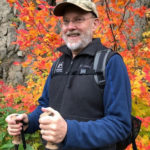 The lone Oregon White Oak (Quercus garyyana) standing majestically above a hillside of prairie grass and flowers, is an icon of the Willamette Valley, and of the Greenbelt Land Trust. For many of us, a landscape of dark green oaks punctuating an open savannah just feels like home.
The lone Oregon White Oak (Quercus garyyana) standing majestically above a hillside of prairie grass and flowers, is an icon of the Willamette Valley, and of the Greenbelt Land Trust. For many of us, a landscape of dark green oaks punctuating an open savannah just feels like home.
Our personal attachment to the oak savanna landscape is not unique; ever since our species’ emergence on the grassy plains of Africa, Homo sapiens has demonstrated a special affinity for mixed, open-canopy woodland and savanna landscapes. With their abundance and diversity of game and edible plants, fuel for cooking and warmth, protection from weather and wide-open views of predators, these landscapes provided everything hunter-gatherers needed. Over the millennia that humans co-evolved with these systems, the landscape imprinted on us, compelling us to seek stands of widely spaced trees over prairie grasses in which to live. In turn, we imprinted our will on the landscape through pervasive, deliberate, and sophisticated management to fulfill human needs.
Oregon’s Willamette Valley is bordered by isolated remnants of the oak savanna and woodlands that once dominated the entire basin from the lower slopes of the Coast Range on the west to the Cascade Mountains on the east. These ecosystems, appealing to the human eye and rich in biodiversity, are among the state’s most endangered, covering only a few percent of the area they occupied at the time of Euro-American settlement in the mid-1800s. Their story illustrates the complex interplay between ecological dynamics and evolving human values, preferences, needs and constraints.
The history of oak savanna corresponds to the history of human presence in the Pacific Northwest; both date back more than 6,000 years to the end of the most recent dry period in North American climate (Stein 1990). It appears the habitat assumed a range of ecosystem functions and disturbance patterns throughout its history (McShea and Healy 2002). For example, tree core data from several sites in the Pacific Northwest indicate Willamette Valley oaks burned frequently by low intensity fires, but only between the mid-1700s and 1900 (Agee 1993). This lack of consistency suggests that oak may have conformed more to variations in human activity than to other ecological processes.
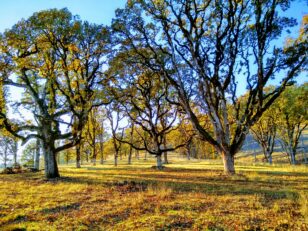 Kalapuya and other local Native American groups were some of the first people to shape Willamette Valley ecosystems to meet their needs. Prior to European settlement they used fire as a management tool to maintain gardens of camas (Camassia spp.), a native prairie plant whose starchy bulb was a food staple, and foster the growth of tarweed, grasshoppers, nut and berry plants, and bracken fern rhizomes (Agee 1993, Boyd 1999). They also set fires to herd deer for hunting. Oregon white oak (Quercus garryana) is adapted to fire in ways that other species, such as Douglas-fir (Pseudotsuga menzeissi), are not. Their thick bark protects the delicate cambium and dormant buds are located low on the root collar below the soil surface so they can sprout even after fire (Tveten and Fonda 1999). The fires the Kalapuya set thinned the understory of the oak woodlands and savannas, maintaining the stands’ open structure, enhancing tree vigor and seedling regeneration and increasing mast crops for consumption by both humans and game (Agee 1993, Agee 1995, Boyd 1999, Peter and Harrington 2002, Van Lear and Brose 2002). The fires also limited infestations by invasive plants and acorn boring insects (Anderson 2005). The fires promoted the local oak species over other tree species. The net effect of Kalapuyan management was to create an overstory of widely-spaced, large-crowned Oregon white oak trees with an understory of shrubs and perennial native grasses (Agee 1990).
Kalapuya and other local Native American groups were some of the first people to shape Willamette Valley ecosystems to meet their needs. Prior to European settlement they used fire as a management tool to maintain gardens of camas (Camassia spp.), a native prairie plant whose starchy bulb was a food staple, and foster the growth of tarweed, grasshoppers, nut and berry plants, and bracken fern rhizomes (Agee 1993, Boyd 1999). They also set fires to herd deer for hunting. Oregon white oak (Quercus garryana) is adapted to fire in ways that other species, such as Douglas-fir (Pseudotsuga menzeissi), are not. Their thick bark protects the delicate cambium and dormant buds are located low on the root collar below the soil surface so they can sprout even after fire (Tveten and Fonda 1999). The fires the Kalapuya set thinned the understory of the oak woodlands and savannas, maintaining the stands’ open structure, enhancing tree vigor and seedling regeneration and increasing mast crops for consumption by both humans and game (Agee 1993, Agee 1995, Boyd 1999, Peter and Harrington 2002, Van Lear and Brose 2002). The fires also limited infestations by invasive plants and acorn boring insects (Anderson 2005). The fires promoted the local oak species over other tree species. The net effect of Kalapuyan management was to create an overstory of widely-spaced, large-crowned Oregon white oak trees with an understory of shrubs and perennial native grasses (Agee 1990).
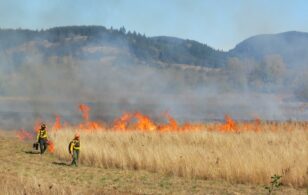 Euro-American pioneers in the Willamette Valley also burned the land (Boyd 1999). Yet these settlers who displaced the Native Americans also brought with them a set of values, preferences, needs and constraints that stood in stark contrast to those of their predecessors. Where Kalapuyans saw prime camas grounds, settlers saw potential pastures and crop fields. In open oak woodlands they saw cabin logs, lumber, and well-drained agricultural fields. And in wildfire they saw a threat to their homes and settlements. As a result, camas fields were ditched and drained, wooded savannas were cleared and plowed, and, in the absence of fires, oak stands developed thick understories and shade-tolerant species, such as Douglas-fir, encroached on and outcompeted oak in the canopy.
Euro-American pioneers in the Willamette Valley also burned the land (Boyd 1999). Yet these settlers who displaced the Native Americans also brought with them a set of values, preferences, needs and constraints that stood in stark contrast to those of their predecessors. Where Kalapuyans saw prime camas grounds, settlers saw potential pastures and crop fields. In open oak woodlands they saw cabin logs, lumber, and well-drained agricultural fields. And in wildfire they saw a threat to their homes and settlements. As a result, camas fields were ditched and drained, wooded savannas were cleared and plowed, and, in the absence of fires, oak stands developed thick understories and shade-tolerant species, such as Douglas-fir, encroached on and outcompeted oak in the canopy.
As the region became the nation’s timber basket during the twentieth century landowners cultivated and encouraged Douglas-fir anywhere it would grow, converting oak-canopied pastures, fields, and woodlands to timber plantations. Farmers shifting to more lucrative crops, such as rye grass, also removed savanna oaks that cast shade onto their fields on the valley floor. In the foothills, woodlands and savannas were converted to residential areas, Christmas tree plantations, and vineyards. Residents in the Willamette Valley viewed open meadows and savanna primarily as candidate areas for conversion to other uses including Christmas tree plantations and conifer plantations, often with assistance from natural resource professionals (Fischer and Bliss 2009).
The Valley is now home to the cities of Eugene, Corvallis, and Salem, and to 70% of the State of Oregon’s population. On sites with better soils, dense stands of Douglas-fir are managed for timber production on industrial ownerships, habitat and water on public ownerships, and mixed objectives on family ownerships. Pure oak stands remain only on marginal sites where other species cannot thrive and for which people have found no other use or value. One legacy of Euro-American settlement that has had a dramatic effect on essentially all Willamette Valley oak sites is the introduction of non-native species, notably Himalayan blackberry (Rubus discolor) and false brome (Brachypodium sylvaticum).
The forest and human landscapes of the Willamette Valley co-evolved; as human needs and culture changed so did landscape structure. Through their use of fire, the Kalapuyans had, in effect, shaped the ecosystems of the Valley to suit their needs; the needs of people living at low population densities in scattered communities moving seasonally across a dynamic landscape. Euro-American settlement, elimination of fire, and shifts in forestry and agriculture further changed the landscape. A century and a half later, subsequent generations of residents are continuing to transform the landscape, shaping it to reflect prevailing values, needs, preferences and constraints.
In the 1990s a movement emerged to protect remnant oak stands and restore oak to the Valley. Catalyzed by the recognition of oak woodlands and savannas as two of the most threatened habitat in the state of Oregon (Oregon Biodiversity Project 1998), the Oregon Oak Communities Working Group formed to support the conservation and restoration of oak. Composed of scientists, extension foresters, landowners and representatives of conservation organizations, the group focused their initial efforts on the Willamette Valley, where oak savanna historically dominated the landscape. The Greenbelt Land Trust has emerged as a leader in protecting and restoring oak ecotypes in the Valley. Many signature GLT projects and properties include oak woodlands and savannahs, including Chip Ross Park, Fitton Green, and Bald Hill Natural Area. These efforts to conserve oak ecotypes represent just the latest in a continually evolving set of values, institutions, tenure arrangements and behaviors shaping our human community’s relationship with our landscape.
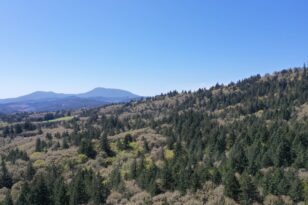
What can we learn from the story of these Willamette Valley ecosystems? First, oak woodlands and savannas are “anthropogenic” ecosystems that co-evolved with their human inhabitants. Indeed, co-evolution might be a useful way to think about the relationship between humans and ecosystems we should strive for through ecological restoration; it implies the possibility and necessity of evolving new human values and behaviors in our relationship to the landscapes we inhabit.
Second, we humans don’t have some generic impact on these landscapes; we imprint them with remarkable detail, reflecting specific values, preferences, needs and constraints, just as their conditions affect human culture. Landscapes themselves are enduring reflections of cultural values, resistant cultural artifacts reflecting past values and beliefs (Nassauer 1995).
Third, determining target conditions for restoration, then, necessarily involves consideration of the behavior and culture that created or maintained the desired ecological condition. Target conditions inescapably reflect and privilege particular patterns of human activity, and the associated values and constraints, over others. Beginning with the claim that an ecosystem is in need of conservation or restoration, one is engaging in choices based upon (often competing) human values, preferences and cognitive constructs.
Fourth, all questions of land use, including restoration, involve issues of tenure; the formal and informal system of rules and practices that govern rights to access, use, and disposal of land and land resources. When Euro-American settlers took up residence in the Willamette Valley, they imposed an entirely different tenure system on the land from that of the Kalapuyans, with profound impacts on land use and management. Since settlement, tenure rights have been continuously renegotiated as social norms for land use have evolved – from commons to homesteads, to timber and agriculture crops, to amenities – and each renegotiation has affected the landscape.
Finally, relationships between humans and landscapes are dynamic, coevolving in response to changing biophysical, cultural, economic, political and social conditions. We humans don’t just occupy ecosystems; we are integral components of complex socio-ecological systems. Recognizing our evolutionary role in co-creating the landscapes we inhabit enriches our understanding of who we are, where we live, and how we might influence the future landscapes of home.
This post has been adapted from “Toward a political ecology of ecosystem restoration” by John C. Bliss and A. Paige Fischer, Chapter 10 in Human Dimensions of Ecological Restoration; Integrating Science, Nature, and Culture, edited by Dave Egan, Evan E. Hjerpe, and Jesse Abrams. Copyright 2011 Island Press. Reproduced by permission of Island Press, Washington, D.C. http://islandpress.org/ip/books/book/silandpress/H/bo8057440.html.
References
Agee, J.K. 1990. The historical role of fire in Pacific Northwest forests. In Natural and prescribed fire in Pacific Northwest forests, edited by J.D. Walstad, S.R. Radosevich and D.V. Sandberg. Corvallis: Oregon State University Press.
Agee, J.K. 1993. Fire Ecology of Pacific Northwest Forests. Washington D.C.: Island Press.
Agee, J.K. 1995. Fire in Restoration of White Oak Woodlands. In The Use of Fire in Forest Restoration: A General Session at the Annual Meeting of the Society for Ecological Restoration, Sept. 14-16, edited by C.C. Hardy and S.F. Arno. Seattle, WA: USDA Forest Service.
Anderson, K. 2005. Tending the wild: Native American knowledge and the management of California’s natural resources. Berkeley, CA: University of California Press.
Boyd, R. 1999. Strategies of Indian Burning in the Willamette Valley. In Indians, Fire and the Land, edited by R. Boyd. Corvallis, OR: Oregon State University Press.
Fischer, A.P. 2006. Private Forests, Public Policy: Oak Conservation on Family Forests in Oregon’s Willamette Valley. Ph.D. dissertation. Corvallis, Oregon: Oregon State University. 262 pp.
Fischer, A.P. and J.C. Bliss. 2009. Framing conservation on private lands: Conserving oak in Oregon’s Willamette Valley. Society & Natural Resources 22(10): 884-900.
McShea, W.J. and W.M. Healy, eds. 2002. Oak Forest Ecoystems: Ecology and Management for Wildlife. Baltimore and London: The John Hopkins University Press.
Nassauer, J.I. 1995. Culture and changing landscape structure. Landscape Ecology 10(4): 229-237.
Oregon Biodiversity Project. 1998. Oregon’s Living Landscape: Strategies and Opportunities to Conserve Biodiversity. Portland, OR: Defenders of Wildlife.
Peter, D. and C. Harrington. 2002. Site and Tree Factors in Oregon White Oak Acorn Production in Western Washington and Oregon. Northwest Science 76(3): 189-201.
Stein, W.I. 1990. Quercus garryana Dougl. ex. Hook. In Silvics of North America, Volume 2, Hardwoods. U.S. Department of Agriculture Forest Service Agricultural Handbook 654, edited by R.M. Burns and B.H. Honkala. Washington D.C.: U.S. Department of Agriculture Forest Service.
Tveten, R.K. and R.W. Fonda. 1999. Fire Effects on Prairies and Oak Woodlands on Fort Lewis, Washington. Northwest Science 73(3): 145-158.
Van Lear, D.H. and P.H. Brose. 2002. Fire and Oak Management. In Oak Forest Ecosystems: Ecology and Management for Wildlife, edited by W.J. McShea and W.M. Healy. Baltimore and London: The John Hopkins University Press.
A few weeks ago we toured the gorgeous property of long-time Greenbelt supporters Cliff and Gay Hall who have granted GLT a conservation easement on sections of their land along the Luckiamute in the Kings Valley. It is a site of special interest in more ways than one. The Halls live in a pioneer dwelling, surrounded by the earliest evidence of settlers in the valley on a homestead between two streams that flow west into the Luckiamute—the sort of Eden migrants from the Midwest prized. But they were not the first people sheltering beneath the oaks. Led by archaeologist Dave Brauner, we wandered through what was perhaps one of the most densely populated areas of indigenous settlements in North America. Centuries of human lives, of human activity lie just beneath the surface. Incomers built persisting structures, cleared land, established sawmills and farms—this much is still evident. But the soil here is conducive neither to excavation nor the preservation of organic remains, plus it’s terribly hard to work with thick clay, so not much has been done to develop ancient sites for systematic exploration. Scant evidence of those centuries of human occupation has yet to emerge into the light again. The oaks above are silent on what transpired in their shadow a century or two ago. Nearby Ft. Hoskins, established only 150 years ago to monitor the newly created reservation on the coast, has recently been restored—much of the feel of the place comes from the fact that many of the trees that once shaded soldiers still shade today’s visitors. And the same is true for the riparian areas of the Hall property—the oaks are the only remaining witnesses to its earliest inhabitants. Everything else lies beneath the green veil. “I am the grass”, Sandburg writes: “Let me work.” And work it does.
Oaks seem impervious to time: impervious, solitary sentinels, as in Whitman’s paean to a Louisiana live-oak—“All alone stood it and the moss hung down from the branches,/ Without any companion it grew there uttering joyous leaves of dark green.” For him, oaks might grow joyously even without companions, without community, and because of that they cannot be like us. Thinking of Whitman’s oak in Louisiana with its collection of Spanish moss (not a true moss but rather an epiphyte. Whitman’s prodigious beard, on the other hand, may well be moss. . . .) we bring to mind an emblem of endurance, outlasting generations of those who marvel at its sheer presence. Yet when you look long, you see that even oaks must fade to grass. And entire forests, one way or another; these days I’m beavering away on a massive Oregon white oak that came down in last winter’s storms—its trunk is easily 3 feet thick, and will yield a full season’s firewood or more. That’s its lone and humble destiny. Not so some of its 19th century European cousins that perished en masse. The battle of Trafalgar, six hours on a late October afternoon in 1805, destroyed hundreds and hundreds of acres of oaks that had been refashioned into French and Spanish ships of the line. English losses were lighter, but their ships too were gone by mid-century: broken up and sold, or left to rot after serving as floating storehouses, gun platforms, or prisons. Dickens’ Magwitch, to Pip’s horror, crawls ashore in the fens after escaping from just such a ship.
Napoleonic–era frigates consumed entire forests. England’s two most famous—the HMS Temeraire and Nelson’s HMS Victory—between them gobbled up nearly eleven thousand English oaks (Quercus robur), drawn mainly from the open forests of Dean in Gloucestershire and Hainault in Essex and harvested at maximum age to strength ratio of around 150 years old. Lumber from trees grown in unfettered forests has natural twists and curves that make it stronger than straight-grained wood and less likely to splinter when hit, and lends itself easily to being fashioned into the distinctive wine-glass shaped hulls—thick branches for the frame’s futtocks– and the bent knees that support the gundecks. For the Temeraire’s hull alone, English shipwrights cut 288,000 cubic feet of oak from Hainault Forest. That’s about 5000 trees, each the size of the one I’m cutting away at for firewood. The stern post, from which the rudder hangs, was 40 feet long and more than two feet thick: pure heartwood. It must have been an impressive tree, well over two centuries old.
A word about Hainault Forest, besides the killing irony of a French name dating back to the Normans for a forest whose legacy is that it supplied lumber for an English navy fighting the French. In Henry VIII’s day, its royal hunting preserve alone covered over 3000 acres. Oak, hornbeam, chestnut—this was a brilliant mature climax hardwood forest. Far better (as the shipwrights tell us) for producing trees than the cramped light-starved royal forests of France, whose density made for long straight trees lacking the compression wood vital to curved supports. Naturally, because Hainault Forest had such fine oak, it was cut to pieces, and never recovered; a Royal Forest for centuries, it was declared ‘wasteland’ by Parliament in 1851, stripped of its remaining old growth, and engulfed by the City of London as thoroughly as the seas off Trafalgar had consumed those doomed French. Only a few hundred acres remain, now preserved by a land trust. In another incandescent irony, the amount of land that trust now guards is roughly the same as the size as the shipyard where HMS Temeraire’s keel was laid and where most of Hainault’s oak lumber ended up. Hainault Forest was not replanted– England’s next navies would be made of iron and in the interim there were other forests: in Canada and New Zealand, for example. Turner’s famous painting of the Temeraire’s last voyage tells all—a squat steam tug belching smoke like a floating furnace towing the de-rigged frigate to the mudflats of Rotherhithe, up the Thames, where she will be broken up. And where some of Temeraire’s Hainault oak futtocks ended as beams in parlours and inns. If you are ever in the presence of a piece of HMS Temeraire’s wood, those around you will point it out. Do your duty, as Nelson famously signalled, and bend a knee.
Nelson’s Trafalgar flagship, the HMS Victory (now a museum), was even larger, and we needn’t go into detail here (roughly 6000 oaks, 27 miles of rope rigging, 4 acres of canvas)—but think of this: at Trafalgar, a few hours conflict involved 60 ships of the line (and many smaller vessels) from the combined navies of France, England and Spain. Each ship was actually a small forest, and together, the floating oak on that October afternoon came to at least 330,000 trees, each over a century old. Not to mention the thousands of trees for masts, spars, sprits and decking.
Some of the trees around the Hall property were shading the banks of the Luckiamute even as the Temeraire bore down off Cape Trafalgar on that fateful late October afternoon in 1805.